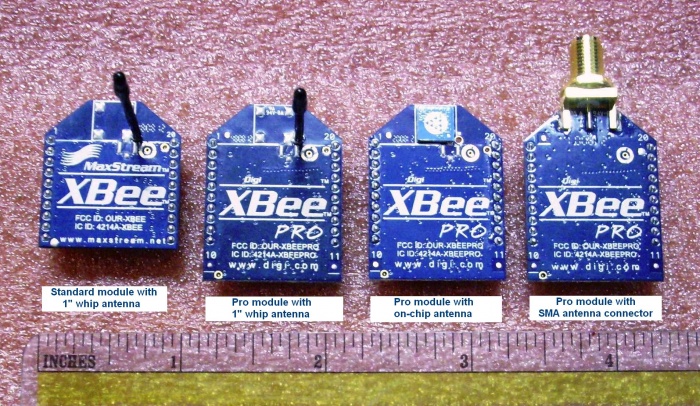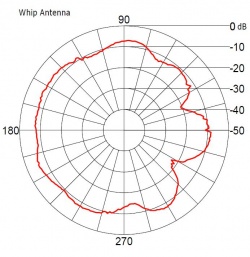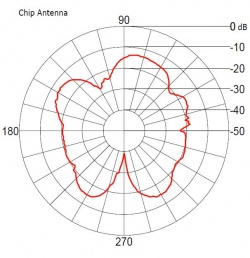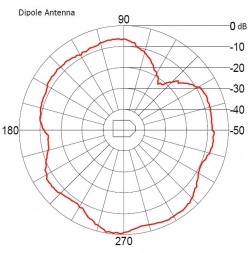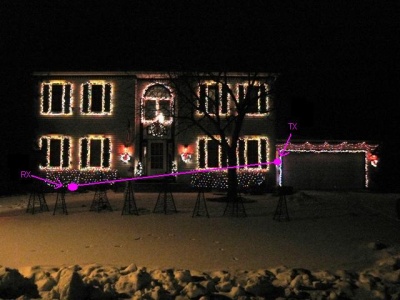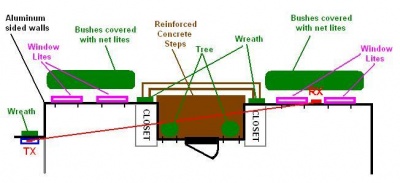Ren-W Antenna Info
Overview
- An XBee radio module needs an antenna to be able to transmit and receive data. Depending on the type of XBee in use, the antenna may be one that is built into the radio or instead, the radio may have an antenna connector so that it may be connected to an external antenna. The examples below show the 1" whip antenna, the on-chip antenna and the XBee with an RPSMA connector, or shortened to the "sma" version of the XBee for connecting to standard Wi-Fi antennas. Not shown is the Xbee radio with the U.FL. connector which is a tiny, snap-on connector on the top of the XBee module for connecting a short U.FL. cable that has an RPSMA connector on the other end.
- The type of XBee module as well as the type of antenna chosen make a difference in terms of distance performance, as noted in the following chart from the manufacturer's documentation:
Radiation Patterns
- An additional consideration is the radiation pattern for each antenna type. The radiation pattern is the horizontal area of coverage the antenna provides. Shown below from left-to-right are the the built-in 1" whip antenna, the on-chip antenna and an external antenna:
- In actual testing over short distances any of the antennas have proven to be adequate but if either very long or wide-area coverage is desired, the obvious choice is to use an external antenna.
Transmission Power Losses/Gains
- The purest environment for the best wireless communication between to devices is where there is a direct line-of-sight distance between the transmitting antenna and the receiving antenna and there is nothing but air between the two. Trees, houses, cars, bushes, rain, plastic -- anything that is physically between the transmitting and receiving antenna will degrade the performance in some way, and it is impossible to know exactly what the effect will be without trying it. There is no formula that says a tree is worth X amount or a house is worth Y amount, because not all trees or houses are alike. LIkewise, it's impossible to know exactly what effect putting the antenna inside a plastic box will have verses using an external antenna on the outside of the box except to say that an antenna outside the box will be more efficient than one inside the box because the plastic will have an effect.
- Another element that can degrade the transmission of a radio wave is the antenna cable between the transmitter (the XBee radio module itself) and its antenna. Both the length and type of cable have an effect on the transmitted power because the cable itself absorbs some of the energy. Obviously, the longer the cable, the more it will absorb. Therefore, one of the main objectives is to keep an antenna cable as short as is practical given the relative locations of the XBee radio module and its antenna. Obviously, the built-in 1" whip antenna gives such good performance because there is virtually no power loss in a cable because there isn't one! But when it comes to external antennas, cable length can become a factor.
- One way to help reclaim some of the transmitting power lost by an antenna cable is to use a high-gain wi-fi antenna. Because the XBee radio operates in the 2.4ghz spectrum, common wi-fi antennas can be used as external antennas and such antennas come in many flavors, lengths, and "gain" values. Gain values are typically measured in "dbi" or "db" numbers so that an antenna that is touted as having 6db gain would theoretically provide better performance than an antenna with only 3db gain, and in fact, 6db would be approximately twice the gain as 3db.
- An antenna with 3db gain is roughly equivalent to doubling the transmission power that arrives at the antenna connector. Therefore, if an antenna cable was so long that it absorbed 50% of the power, using a 3db gain antenna would roughly double the transmitting power of the remaining 50% power back up to 100%. Using an antenna with 6db, 9db or even a greater gain value could perhaps work even better, at least theoretically. But there comes a point of diminishing returns with matching antenna cable length and antenna gain -- it's still best to keep the cable as short as possible.
Antenna Position and Orientation
- There's a reason why television and radio stations have their antennas mounted atop high poles: a high pole provides for longer line-of-sight distance. Therefore, it's logical to say that if your antenna is on the ground, it probably won't perform as well as if it were mounted six or ten feet above the ground.
- The orientation of the antenna to the ground is also important because radio waves emit outward from the antenna's radiating element. One of the weakest points is the tip: aiming with the tip of an antenna generally yields poor results because not much is emitted from the tip. The best transmission/reception combination is when the transmitting and receiving antennas are parallel to one another. If the tranmitting antenna is vertical to the ground, the receiving antenna should be vertical to the ground, too. Therefore, if you require long distance, you'll want to pay attention to the orientation of the antenna to ensure efficient communication.
Let's Be Practical
- Good news: in actual practice, if your receiving XBee Pro radios are less than roughly 75 feet from the transmitter, it doesn't seem to matter what kind of antenna you use, whether they're inside or outside of a plastic case or whether they're laying on the ground or the antennas are parallel with one another. Therefore, for most situations, it seems that either the 1" whip or even the on-chip antenna should suffice for most users.
- More good news: the lower-powered regular XBee module has the same antenna options as the pro model, and if your transmission distances are roughly 50-feet or less, you can save some money by using the regular modules instead. Also consider that using a high gain antenna with a regular XBee effectively boosts its power and sensitivity so that a regular XBee with a 9db antenna may actually perform like an XBee Pro with a 1" whip. (Of course, you'll have to weigh the plusses and minusses here -- the cost of the antenna plus the regular XBee may actually exceed the cost of the XBee Pro itself...)
- Still more good news: All XBee modules have the same pin connections so that regular and pro versions can easily be swapped-out provided that (1) you've used the plug-in headers and have not soldered-in your XBees and (2) the radios to be swapped have the same antenna type. If you use the Ren-Ws in global broadcast mode, remember that the addressing is in the Renard controller and not in the XBee itself for all channels controlled from the same COM port. Therefore, the XBees modules are interchangeable for all controllers on the same COM port and if you move a display to a far corner of your yard, you can easily swap out a regular XBee with an XBee Pro when more distance is needed. Obviously it gets a lot easier if all of your XBee modules are identical, but if you're careful with where you place them in your display, you can save money by mixing and matching regular with pro models.
An Example of What NOT to Do
- Here's an example of my own attempts to make something work that couldn't possibly work. The sympton was a remote controller with a Ren-W that was behaving quite erratically and rarely in sync with the rest of the lights. Sometimes it wouldn't fire any channels at all. This Ren-W/Ren64 controlled the lights on the entire left front side of the house (4 windows, 1 wreath, 1 tree, and sets of net lights on bushes) so when it was misbehaving, it was pretty obvious, and really ugly to watch.
- The transmitter is located inside the garage against the back wall of a cabinet. It's a Rev-6 Ren-W board with an XBPro - SMA version, with an 11" (9db gain) wi-fi whip antenna, pointed vertically. The house has aluminum siding on all outside walls so I thought maybe the 9db gain whip antenna would overcome the attenuation from the aluminum siding.
- The receiving Ren-W (also a Rev-6 board) was attached to a Ren64 and inside a CG-2000 case, sitting on the ground behind bushes on the front of the house, about 75 feet away (straight line). The XBPro radio inside had the 1" mini-whip antenna, and it was aligned vertically to match the transmitter.
- The photo of the front of the house has notations of where the transmitter and receiver were. The second photo is an overhead drawing of what the radio wave had to go through to get to the receiver. As it turns out, I was trying to transmit through 4 layers of aluminum siding, 6 walls, through a reinforced concrete front step, through electrical interference caused by at least two of the wreaths on the front of the house and two trees in the entryway, and of course the lights around the windows. Also, consider that the bushes the receiving Ren-W was under were also covered with net lights. I was asking the XBee radios to do the impossible.
- The eventual solution was to mount an 11" wi-fi whip antenna onto the top of a 2' length of PVC, and place it near the center of the yard and run a wi-fi antenna extension cable from the Ren-W in the controller box to the new pole-mounted antenna out in the yard. After installing the new antenna, the problem was completely solved because the obstruction ceated by the multiple walls and other electrical devices that were between the transmitter and receiver had been eliminated.
- The bottom line of this example is that careful consideration must be made as to where you put the transmitter and receiver(s) so as to maximize the direct, line-of-sight communication between the units as best as is possible. The more impediments you place between the transmitter and receiver, the more misfires you'll have.
Antenna Questions/Answers
What are the part numbers for the various XBee antenna types?
- Mouser's part numbers for XBee Pro modules currently are:
- 888-XBP24-AWI-001 --- 1" whip antenna
- 888-XBP24-ACI-001 --- on-chip antenna
- 888-XBP24-AUI-001 --- U.FL. antenna connector
- 888-XBP24-ASI-001 --- RPSMA antenna connector
- Mouser's part numbers for regular XBee modules currently are:
- 888-XB24-AWI-001 --- 1" whip antenna
- 888-XB24-ACI-001 --- on-chip antenna
- 888-XB24-AUI-001 --- U.FL. antenna connector
- 888-XB24-ASI-001 --- RPSMA antenna connector
How much will a 12-foot antenna cable affect my power output and distance?
- I have no clue. Try it and find out.
Can I tape an antenna onto a window?
- Sure. It's a free country, do what you like. A glass window would probably be preferred to mounting the antenna behind a wall that has metal siding on the outside of the house.
I have a location problem for the transmitter as my PC is in the basement. Will an inside transmitter still work from there?
- There's a reason why radio stations use antenna towers -- radio antennas are rarely very successful when they're underground. If it works at all, it probably won't transmit very far. Either mount the Ren-W in a higher location and run a longer cat5 cable from your PC to it (preffered solution) or a less adviseable solution is to use a long antenna cable from the Ren-W's XBee to an antenna mounted above ground. In the latter solution, the long antenna cable will eat up some of the transmission power while the former solution will be more efficient.
Can I use an XBee USB Explorer board as my transmitter?
- Yes, by all means. It's a GREAT transmitter. It appears to your computer as a serial port and you configure Vixen to send the output to that serial port. Works great!
Since my USB cable is only 3 feet long, can I get a longer USB cable so I can mount my XBee USB Explorer board upstairs?
- Yes, there are many inexpensive USB extenders available that can work, although making a long USB cable probably won't because USB has some limitations there. USB extenders generally work by first converting the USB signal into RS485 and then reconverting it on the other end from RS485 back into a USB connection. One such product is the USB Extension Cable, product #6042 from Monoprice (www.monoprice.com). This adapter provides a way to extend a USB connection up to 150 feet.
Will it work to put the transmitter inside the house and the receivers outside?
- Maybe.... well probably.... but maybe not... It depends on how thick your house's walls are and what they're made of, how far it is to the receiving Ren-Ws, whether the receivers are inside boxes, whether they're on the ground, how high your antenna is, what kind of antenna you use... uhhh... this is DIY... did you bother to read any of the above information???
I'm still confused. Why can't somebody just tell me what to do?
- Welcome to DIY. But if you want to cover all the bases, first go to your bank and take out a loan. Then purchase only the XBee Pro modules with the RPSMA connector, then for each of the XBee modules purchase one of the highest-gain wi-fi antennas you can possibly find; purchase some short, medium and long antenna extension cables with appropriate RPSMA connectors on both ends and have at it.
Additional Ren-W Links
